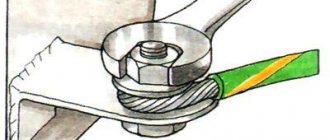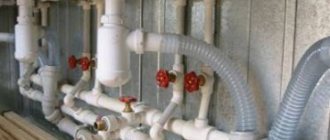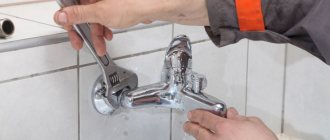Dismantling and installing new communications is an integral part of any major renovation. Usually, replacing pipes in a bathroom is carried out by the plumbers of the management company. It’s true that you can dismantle old elements and install new ones yourself, if you know how it’s done. Do you agree?
We will tell you how pipeline repair work is carried out by replacing dangerous sections. The article we presented describes step by step methods for removing worn pipes and methods for attaching new ones. Using our advice, you can restore the tightness of a trouble-free system.
Stages of preparatory work
Like any household work, replacing old sewer pipes will be faster and more efficient if you evaluate the work in advance, draw up a plan and carry out thorough preparation. The entire volume can be divided into several stages.
Planning and purchasing materials
Due to the fact that in this case the sewerage system will not be installed from scratch, but only the pipes will be replaced, design work can be simplified. However, they must be carried out in two cases:
- it is planned to change the design of the engineering system, taking into account the shortcomings of the previous version;
- new consumers need to be added.
If the system functioned successfully, experts recommend laying pipes along the old route and using existing technological holes in the partitions.
Before replacing a sewer pipe, it is necessary to clarify the number and nature of water intake points in the apartment or house. They are: household appliances, namely washing machines, dishwashers, sinks, toilets, bidets and others.
In this case, it is easier to purchase materials. When compiling a shopping list at a building materials store, you will also need measurements of the old pipeline and a census of the fittings used. Naturally, new sewer pipes and fittings will be qualitatively different than dismantled ones, since the industry for their production is rapidly developing, offering more and more effective solutions, but the quantitative volume will be the same. You just need to provide a certain reserve.
Pipe measurements
Today, polymer pipes are mainly used for sewer installation; steel pipes are less commonly found, the installation of which is associated with certain difficulties.
Dismantling
When the old system has been studied and the places that need to be changed have been specified, you can begin to dismantle it. Basic rules for dismantling:
- It begins with the fact that furniture and household appliances that may interfere and are subject to the possibility of being damaged are removed from the premises.
- First turn off the water supply and also disconnect the hose that leads to the toilet flush tank.
- Old sewer pipes are cut into fragments using a grinder and taken out of the apartment or house.
- If the place where the pipe runs is far from the riser, and you can’t get there with a grinder, you can simply break it with a hammer or sledgehammer, since cast iron is quite fragile.
Sewage dismantling
Tool
To carry out dismantling and subsequent installation, you must have special tools on hand. Their presence will significantly reduce the work time and optimize it. To simplify the replacement you will need the following tool:
- pencil;
- roulette;
- Bulgarian;
- set of wrenches;
- die;
- scissors;
- Master OK;
- chisel;
- screwdriver.
If desired, this list can be expanded with additional tools such as a drill, crimping pliers, etc. Their presence is not necessary, but still allows you to fix the pipes and connections more reliably.
Installed heated towel rail
Installation of internal wiring
After installing the riser, it is necessary to change the internal wiring in the apartment. The work rules include the following recommendations:
- The wiring is carried out from the central riser to the plumbing fixtures (toilet, sink).
- It is necessary to install not only rigid, but also moving elements of the pipeline. Moving elements made of corrugated pipes relieve the internal stress of the system.
- The sockets should be positioned towards the flow of wastewater, this reduces the risk of leakage.
- The sewage system must be installed at a slope towards the drainage direction.
- A pipe with a diameter of 110 mm is used to drain water from the toilet.
- For all other plumbing fixtures, a 50mm diameter pipe must be used.
After installing the wastewater disposal system, the drain tank is connected and a test run is performed. The correct operation of the flush tank depends on the correct connection to the toilet and the tightness of the connection with the supply pipe. There are also cistern models that need to be mounted to the wall. All necessary components for installation are usually supplied with the equipment. Also, the cistern device can be hidden inside a plasterboard structure, which will add aesthetics to the restroom room.
Compliance with simple recommendations for laying a drainage network guarantees the reliable operation of all plumbing fixtures in the apartment, the absence of leaks, extraneous noise and odors. If difficulties arise when carrying out the work yourself, you can call qualified specialists.
Diameter selection
Before purchasing building material, it is necessary to calculate the volume of waste water produced by water consumers. It is not recommended to save money by buying an inexpensive product with a narrow cross-section.
The recommended drain diameter in the wiring diagram is taken as follows:
- riser in the restroom - 100-125 mm;
- outlet from the bathtub and shower cabin - 50 mm;
- toilet and bidet drain - 100 mm;
- outlet from the kitchen sink - 50-70 mm;
- dishwasher and washing machine outlet - 32 mm.
For installation of external sections, only rigid pipes that can withstand strong mechanical loads are required.
How to dismantle a cast iron pipe
If a pipe is “welded” to a wall or floor using sulfur or aluminum, it will be very, very difficult to destroy such a coating.
To get started, you must first turn off the water supply to the apartment. Then you need to free the bathroom from unnecessary items that you can damage during work. This includes the sink, washing machine, laundry basket, etc.
Next, you need to disconnect the flush tank from the water supply and dismantle the toilet itself. Problems may also arise here, since Soviet toilets were screwed to the floor conscientiously, in other words, tightly.
Try to unscrew the bolts that attach the toilet to the floor and remove it from its place. If you succeed, consider yourself half done.
Now comes the turn of the pipes themselves. Cast iron, as you know, is not particularly strong, so at some distance from the riser you can simply break the old pipe with a hammer. It is much more difficult to remove the remains of pipes from the old riser and clean them before installing new ones.
To dismantle pipes, you may need:
- A hammer with a rubber or plastic tip.
- Chisel
- Torch or blowtorch
- Mask
Quite a strange combination, isn't it? However, a gas mask is necessary to comply with safety precautions if the joints of sewer pipes in your bathroom are filled with sulfur.
The easiest way to remove sulfur is by heating it. However, when heated, the sulfur mass releases toxic substances into the air, which are extremely harmful for humans to inhale. That is why it is better to protect yourself with a gas mask in advance.
So, dismantling must begin at the point of greatest distance from the riser. Here, most craftsmen do not bother with the torch, but simply break the pipe with a hammer. This is much simpler, but can cause some complications.
Make sure that when broken, pieces of pipe do not fall into the sewer passage. They can cause serious clogs in the drain, which will be much more difficult to get rid of than getting rid of old pipes.
With a hammer, you can destroy the pipe up to the crosspiece inserted into the riser. Here it is somewhat different and filled with much more sulfur.
To free the pipe and cross from the layer of sulfur, you need to heat it. The impact of a burner or blowtorch can last for several hours, while harmful substances will be constantly released.
Before you start heating, isolate animals and household members, cover furniture or other furnishings located in the immediate vicinity of the riser, and put on a gas mask.
During the heating process, you can easily chip off pieces of sulfur until the pipe is sufficiently clean. Now, the cross inserted into the riser must be loosened if possible and removed from the riser.
The dismantling of the old pipeline is carried out as much as possible. That is, all possible pipes are removed, and others are installed in their place.
Connecting a new PVC pipe to an old cast iron riser will require certain operating skills. Please note that you must clean the connection area as much as possible from the same sulfur and rust.
To make the job easier, use a special coupling that is specifically designed to connect cast iron pipe and PVC pipe.
If you still have questions, take a look at ours and ask them there. Our experts will help you understand the intricacies of good construction and renovation.
From time to time, the pipeline wears out under the influence of mechanical load and the sewer pipes in the apartment need to be replaced. Most often, this problem is faced by residents of old houses, where over the years cast iron pipes rust, cracks appear and leaks occur.
To change drain lines, you must first properly dismantle the old pipes. Successful completion of the task requires the availability of the appropriate plumbing tools and necessary components.
Which pipes to choose for a replacement bathroom?
Modern materials have many advantages compared to those that were used before (cast iron, ferrous metal, etc.). Nowadays, so-called plastic materials are widespread.
Watch the video
These include polypropylene, cross-linked polyethylene, metal-plastic, etc. We strongly recommend using them, and later in the article we will justify our statement.
Before replacing the pipes in the bathroom with plastic ones, you need to determine the type of material to be replaced. The construction market is filled with products of various brands; to understand which ones to use, consider their advantages and disadvantages.
Watch the video
Sewage system, what we pay attention to when choosing
Here the choice is small - you can use traditional cast iron or new generation plastic products.
Plastic ones work better because their internal surface is of better quality and does not contribute to the formation of blockages. They are also lightweight, making them easy to transport to site.
It is also not difficult to install them. The connections are made into a socket, where rubber cuffs are used as a seal. All sizes are fully provided with fittings for creating drain networks of any degree of complexity.
Materials for the production of sewer pipes are:
- Polyethylene (PE) is a product of the polymerization of ethylene gas at elevated temperatures and pressure. Depending on the production technology, a distinction is made between low-density polyethylene (HDPE) and high-pressure polyethylene (HDPE). It should be remembered that the first material is better in terms of strength and temperature characteristics.
- Polyvinyl chloride (PVC).
- Polypropylene (PP).
Other polymer plastics are also used for the production of sewer pipes, but much less frequently. They will not be considered as part of our review.
To replace the drain pipe in the bathroom, it is better to use polypropylene products that can stably withstand temperatures up to +75 degrees Celsius and short-term increases up to +95.
It is doubtful that the discharge in this part of the system will reach these values. For the external drain network, it is quite possible to use low-density polyethylene (HDPE), since the liquid in them has a lower temperature, and they cost noticeably less.
To replace drainage systems in the bathroom, pipes measuring 30-40 millimeters, less often 50, are used.
Before you change the pipes in the bathroom to plastic ones, you need to study all their characteristics and choose the appropriate option.
Selecting material for hot water pressure pipelines
What makes it advisable to use plastic products is their inability to form plaque on the internal walls. Chemically, the material is absolutely passive and resistant to most household aggressive substances, and limescale simply does not form on them.
The most dangerous effect is exerted by oxygen in the air, which penetrates into the water from the outside through the pores and microcracks in the product.
At the same time, it does not directly affect the material, but contributes to accelerated chemical wear of the metal parts of the pipeline, which in the bathroom is the heated towel rail and shut-off valves. As a result, they often need to be replaced.
To eliminate this drawback, oxygen protection was invented. For this, aluminum tape with a thickness of 0.1 millimeters is used. It is wound onto a base, which is a pipe-shaped blank, along a helical line.
During the production process, the joint is continuously welded using a laser machine. Then another layer of plastic is applied over the metal jacket. In this way, a three-layer product is obtained, in which the internal cavity is hermetically protected from oxygen penetration.
At its end section, the metal shirt can be seen as a thin shiny strip. In addition to the standard marking, a longitudinal red stripe is applied to the outer surface.
For hot water piping, it is preferable to replace the pipes in the bathroom with polypropylene pipes with oxygen protection.
Cold water pressure pipes made of plastic
Products made from various materials are suitable for such purposes.
A safety margin for pressure is given to them by the installation of a fiberglass reinforcing belt. The production technology resembles the installation of a protective jacket made of aluminum, only instead of it fiberglass threads are wound. On the end section, such a reinforcing layer is distinguished by a dark concentric stripe. The outer surface is marked with a blue longitudinal stripe.
For internal wiring when replacing a bathroom, products with a diameter of 20-25 millimeters are used, for bends to specific consoles - 16.
Removing a Cast Iron Pipe
Dismantling the riser begins with removing the pipe located between the tee and the ceiling. First, a ring-shaped gap is made on top of the section. To do this, at a distance of 12-16 cm from the ceiling, using a grinder, a cut is made in the pipe with a wall remaining of about 3-5 cm.
An incomplete cut is needed to prevent the tool from jamming during possible vertical movement of the column. Then, retreating 9-13 cm down, a similar cut is made, parallel to the first. The ring between the cuts is carefully knocked out with a hammer or using wedges.
The next step is sawing the cast iron section from the bottom. To implement this, an incomplete cut with a grinder is made at a height of 50-70 cm from the upper socket of the tee. The clamps securing the section to the wall are removed (they can simply be cut off with a grinder). The pipe is broken by rocking or hitting with a hammer at the place where the cut is incomplete and is removed from the column.
Removing the tee
The most important operation of the entire dismantling of the old sewer system is the removal of the tee from the socket of the lower section of the riser
As noted, there is an important condition: this bell must not be damaged. The simplest dismantling options are used when filling the joint with cement mortar
First, an attempt is made to disconnect by loosening.
A crowbar is placed in the hole in the remaining pipe, with its help creating bending forces in different directions. Most often, such loosening destroys the cement bond, and the tee can be removed from the lower socket. If the joint is destroyed, large cement pieces should be prevented from getting inside the pipe, that is, the cement is removed from the socket with a screwdriver or chisel.
If loosening does not lead to a positive result, then you will have to use a more labor-intensive method: the cement mass is destroyed using a chisel and hammer
Given the fragility of cast iron, this procedure should be carried out very carefully, and the impact force should be applied away from the walls of the socket. The goal is to provide a gap between the tee pipe and the socket walls
As cement pieces break off, they are immediately removed from the joint area.
The most difficult method of dismantling has to be used when filling the joint with sulfur. This composition is very durable and does not lend itself to the methods of destruction described above. In this case, heating the connection area using a gas torch or blowtorch is most often used. The work is carried out by two people. One worker heats up the joint, and the other loosens the tee.
When the mass melts, the tee is easily removed from the socket
Such work is carried out with the release of very harmful gases, which means it is necessary to take precautions (respirator and safety glasses)
Finally, extreme circumstances may arise when it is not possible to remove the tee from the lower section in any way (it is impossible to use heating, particularly strong pouring and other non-standard situations). In this case, the most undesirable option is used - the tee is cut off at a height of about 5-6 cm from the socket. The end of the remaining pipe is carefully leveled, and subsequently, when installing plastic pipes, you will have to use a coupling.
If you plan to install new plastic sewer pipes, then it is impossible to do without the rather labor-intensive dismantling of the old cast-iron sewer system. This process can cause a number of difficulties, so you should prepare in advance to solve emerging problems.
When replacing a used pipeline, the most difficult task is considered to be dismantling the cast iron pipe. Adding to the complexity of the work is the material used to connect the pipes. Previously, for reliable joining of pipes, they used cement mortar, sulfur or aluminum (see. Thus, the entire structure became almost monolithic. The cement composition is quite easy to remove, but sulfur and aluminum require maximum effort (see).
Dismantling worn-out elements of the sewer line
In order to repair the sewer system in an apartment, it is necessary first of all to identify the location of wear. If there is major damage to the drainage lines, it is enough to simply turn off the water supply in the apartment, remove the plumbing fixtures and begin removing the worn-out area. If you need to replace the sewer riser, you must coordinate your actions in advance with your neighbors, because their water supply will have to be cut off as well. The exact time it will take to repair sewer pipes is difficult to calculate in advance. However, proper preparation and following the intended plan will ensure the successful completion of the process.
Removal of damaged sewer sections consists of the following steps:
Shutting off the water supply to the apartment or to the entire riser. Disabling the flush tank device in the toilet. To dismantle the flush tank, you need to disconnect the water supply hose. Dismantling the toilet. The process is quite labor-intensive; you will need to free the base of the toilet. Sometimes it is enough to simply unscrew the bolts, but sometimes you have to remove the layer of tiles around the toilet leg. Dismantling the toilet must be done using a special tool: a wrench, a chisel, a hammer. Dismantling of the sewer system. Old pipes cannot be reused, so they can be dismantled using physical force and a hammer without sparing. If the replacement of sewer pipes will be carried out only in your apartment, at the next stage you will need to cut the riser using a grinder. The cut pipe should be carefully removed using a hammer and chisel. You can try to remove the lower part of the drainage system near the riser by simply rocking it to the sides. If this manipulation does not lead to the desired result, you will need to make cuts using a grinder
How many cuts to make on the pipe is not so important. The main thing is to split it in order to remove individual fragments in the future. Clean the socket from grease, cement residues and other contaminants, and prepare for installation.
Installation of a heated towel rail
A heated towel rail is an essential attribute of every bathroom, especially if there is no balcony. Its replacement is also a pressing issue, since over time, metal pipes become overgrown with a layer of rust, becoming less efficient. The replacement of the heated towel rail is carried out jointly with the water supply networks and is thought out in advance. The procedure for dismantling and installing the dryer is carried out according to the following rules:
- The heated towel rail is installed on heating or hot water pipes. The second option is easier to implement and does not require coordination with utility services.
- We install taps on the branches prepared in advance, which will allow you to turn off the device in case of an emergency.
- We fix the taps in the bends and immediately transfer them to the closed state.
- After the tap, we install an adapter of the required diameter, which will allow us to continue the network and connect the heated towel rail to the water supply network.
- We tighten the union nuts until they are completely secured and open the taps, starting the flow of water into the system.
To check the functionality of the heated towel rail, leave both taps open for a day. If during this time the system does not begin to leak, and water oozes from the connections, then the device is installed correctly and will work fully.
Installation of a heated towel rail
Calculation of sewer pipeline
Selection of sewer pipe material
Of all the possible types of sewer pipes for DIY repairs, choose pipes made of polymers.
Advantages of plastic pipes:
- Corrosion resistance.
- Chemical resistance.
- Easy to assemble.
- Light weight.
- Smooth wall surface (inner).
- Resistant to low and high temperatures.
- Easy to repair.
- Durability.
Compared to metal pipes, plastic products are more fragile, so care must be taken when handling and storing them. This disadvantage is compensated by its light weight and ease of installation.
Selecting the diameter of the sewer pipe
Minimum permissible diameters:
- Bidet, washbasin, sink – 40 mm.
- Shower cubicle, bath – 50 mm.
- In the case of including several plumbing fixtures in one pipe - 85 mm.
- The riser (main) of a house or apartment is 100 mm.
The versatility of the system can be achieved by using a 50 mm diameter pipe to connect all plumbing fixtures, except the toilet, and make the main riser from a 110 mm diameter pipe; connect the toilet to the same 110 mm sewer pipe.
Calculation of the number of system elements
To calculate the pipeline and install sewer pipes, it is necessary to draw up a diagram of the future system. Simply take a sheet of paper and place on it all the plumbing fixtures that need to be connected.
Approximate diagram of an intra-house pipeline
It must be taken into account that it is not recommended to use bends with an angle of 90°. In this case, it is better to use two 45° bends, which significantly reduces the likelihood of blockage in the pipe.
A large assortment of fittings - angles, crosses, tees, couplings - will allow you to select the necessary element of the desired configuration and the required diameter. If you plan to install another plumbing fixture in the future, then determine the installation location and add it to the diagram. When installing the system, this outlet will be closed with a plug until it is needed.
Having selected all the necessary pipes and fittings according to the diagram of the future pipeline, you can proceed to the next stage of repair.
Advice from professionals
Let's take a break from the step-by-step instructions for a moment and focus on one extremely important point that should be thought through in advance - we are talking about masking pipes. There are several methods of disguise, so we will choose the most suitable one:
- under the bathtub, washbasin;
- in special boxes that are made to hide pipes, as well as to facilitate access to them;
- behind the toilet (or bidet);
- for a special faience element.
A few other recommendations from experts
- It is advisable to place as few pipes under the floor as possible.
- It is not recommended to bend the lines (if this is impossible, then use special adapters at the corners).
- It is better to groove walls only if absolutely necessary.
Sequence of work
Some may think that dismantling old communications can be done quickly and without problems. However, it is necessary to take into account that the riser passes through several apartments, which means that if it breaks, many people will suffer. Dismantling is a plumbing job of increased complexity. Some experience working with tools and equipment and compliance with safety precautions are required. Therefore, such responsible work must be entrusted to qualified specialists.
To completely eliminate possible emergency situations, it is necessary to perform the following manipulations:
- turning off the water flowing through the riser;
- disconnecting the hose that goes directly to the toilet;
- dismantling the toilet, for which you unscrew the mounting bolts;
- all unnecessary materials, equipment, household appliances and plumbing fixtures are removed from the room so that there are no unnecessary obstacles to dismantling;
- pipes located a little further from the riser are dismantled with a hammer;
- get rid of structures leading to the riser;
- A special cuff is installed on the socket of the tee, for which the old lubricants are removed in advance. If this is not done, then it is impossible to talk about high-quality installation of the new system.
Important! Careless installation of the cuff can damage the tee. In such a situation, it will be necessary to replace a certain section of the riser, which will entail additional costs.
Dismantling Guide
Due to the fact that the sulfur used to connect sections of communications tends to harden, demolition will be difficult. So how can you understand what composition was used for fastening? To find out, you need to bring a blowtorch to the connection. An unpleasant odor and melting indicate the presence of sulfur.
Dismantling joints with a torch or blowtorch
To destroy a pipeline where there is a connection using sulfur, you will need a hammer, chisel, blowtorch or torch. Sulfur is a chemical element, so when heated it will begin to release harmful substances into the air. They are poisonous to humans and harm everything around them. Moreover, the heating process can last several hours. Therefore, you will need a gas mask and other protective equipment to prevent the fire of nearby equipment or furniture. You can use a protective screen made of a metal base or asbestos.
Detailed instructions on dismantling communications
Dismantling the system begins with the elimination of pipes located at a distance from the riser. For operational work, use a hammer and chisel. After all, cast iron itself is a rather fragile material, and accordingly, it is easily susceptible to mechanical destruction.
Important! To disassemble pipes, it is not recommended to use a hammer with a metal attachment. If you do not calculate the force of the impact, the hammer will fall inside the pipe, which can cause a large-scale blockage of the sewer system or the lumen of the pipeline will close.
A hammer with a polymer attachment is suitable for the job.
The pipe removal process includes several stages:
1. Work with a hammer is carried out until the cross in the riser becomes visible.
2. It is necessary to loosen the crosspiece. This procedure is easier to do when there is a small section of pipe remaining. However, some wizards do not leave extra in order to fully open the connection.
3
Wear all protective equipment and take precautions using protective screens. If two professionals are involved in dismantling, the work will take less effort and time
One specialist heats the sulfur, the second, at the same time, loosens the pipe, breaks off and removes the viscous sulfur.
4. The crosspiece can be easily removed from the riser when most of the sulfur has been removed.
Important! Care should be taken when removing pipe attached to a tee. Part of the pipe is cut off with a grinder. In this case, a fragment no longer than 10 cm should remain.
Then this segment must be loosened and removed.
In this case, a fragment no longer than 10 cm should remain. Then this segment must be loosened and removed.
Carrying out work
Dismantling an old sewer system includes several main stages: dismantling the intra-apartment pipe distribution, removing the cast-iron riser pipes and dismantling the tee (cross).
Removing the indoor system
When carrying out a major overhaul, it is advisable to completely disassemble the wiring (to the kitchen and other devices). If the joints are made very firmly, then there is no point in wasting time disconnecting all the elements.
It is simply cut as close as possible to the socket of the tee using a pipe cutter or grinder. Difficulties with disassembly may arise if the pipes were previously masked with floor coverings - they will have to be carefully removed. It’s even worse if the pipes get under a concrete floor screed. In this case, you will have to work with a hammer drill, a chisel (chisel) and a hammer.
Dismantling the old sewer system
Dismantling of sewer pipes begins with preparing the premises. It is necessary to clear the workplace of all unnecessary things in order to gain full access to the riser and sewer pipes. You also need to prepare a tool for the job: a hacksaw, a grinder, a set of screwdrivers, a hammer, a hammer drill, a chisel, a needle file.
Dismantling stages
- If you are making repairs in a multi-storey building, then you need to agree with the neighbors on the sewer riser that at such and such times they will not use the sewer. Otherwise, all the waste will end up in your workplace.
- Turn off the water.
- Disconnect the water supply hose to the drain tank.
- Remove the toilet, first unscrewing the bolts securing it to the floor.
- Disassemble and dismantle old pipes.
Dismantling cast iron pipes
Since the old sewer system is made of cast iron pipes and fittings with sockets, dismantling will not be difficult. The pipes need to be pulled out of the sockets using auxiliary tools - a chisel and a screwdriver. If the joint cannot be disassembled, then you should use a grinder or a hacksaw
By making cuts in the required places and carefully hitting with a hammer, you can remove part of the system
Particular attention should be paid to work at the junction with the main riser. You cannot use a hammer here, as this could damage the integrity of the entire building sewer system.
The tee connected to the riser is carefully cleaned of the remnants of the old seal. If during disassembly it was not possible to pull the pipe completely out of the joint with the riser, then using a grinder with a small circle (the diameter of the cutting circle should allow it to go inside the tee), cut the rest of the pipe into pieces and pull them out with a chisel. If necessary, you can use a hammer drill with a metal drill.
Find out when replacement is required
This may be due to the following circumstances:
- physical wear expressed in the formation of leaks;
- clogging of old metal pipelines with corrosion products and lime deposits on the walls, which can lead to complete blocking of the lumen in them;
- vibration of the pipeline system due to pressure changes, which can lead to complete destruction of the water supply system.
Let's determine what pipelines are installed in the bathroom. To do this, let’s pay attention to the temperature of the water in them. She may be:
- hot – for domestic needs;
- cold - in the order of general water supply for various household needs and mixing with hot water to the desired temperature;
- hot heating systems;
- since on average more than a cubic meter of water can be spent per person for household needs alone, the task of removing used liquid through a gravity sewer system is urgent (in private houses in the summer season this amount increases to 3 cubic meters).
Not so long ago, for the installation of pipelines in the bathroom, steel water and gas pipes were used, manufactured in accordance with GOST 3262-80 with dimensions of a quarter of an inch and above.
For the bathroom, the optimal size was usually chosen to be up to an inch and a quarter in size. Before you change the pipes in the bathroom yourself, you need to carefully familiarize yourself with the stages of the process. We'll look at them below.











